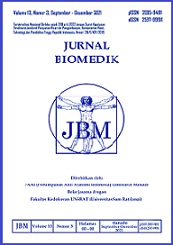Uji Efek Daya Hambat Jamur Endofit Rimpang Jahe (Zingiber officinale Rosc) terhadap Bakteri Staphylococcus aureus dan Escherichia coli
DOI:
https://doi.org/10.35790/jbm.12.2.2020.29163Abstract
Abstract: Ginger rhizome contains antimicrobial compounds of phenol group, flavonoids, terpenoids, and aetheric oil. Endophytic fungi are commonly found in ginger plant Zingiber officinale Rosc. which is widely available in Indonesia. There is a symbiosis between these endophytic fungi and its host plants in a form of genetic material transform, thus these fungi could produce the same active compounds as the host does, or at least involved in the host’s biosynthetic pathway. This study was aimed to determine the inhibitory effect of endophytic fungi isolated from ginger (Zingiber officinale Rosc) against clinical isolates Staphylococcus aureus and Escherichia coli. The endophytic fungi were isolated and their activities were screened. Initial screening of 6 isolates showed that only 3 isolates had relatively strong inhibitory effect against the bacteria. Therefore, they were cultured again, and their extracts were tested against the same types of bacteria. The mean diameters of the inhibition zones against S. aureus were, as follows: 18.7 mm (JJR extract), 11 mm (JJA 1.3 extract), and 17.3 mm (JJA 2.1 extract). Moreover, the mean diameters of the inhibition zone against E. coli were, as follows: 18 mm (JJR extract), 17.3 mm (JJA 1.3 extract), and 23.3 mm (JJA 2.1 extract). In conclusion, endophytic fungi isolated from Zingiber officinale Rosc. had inhibitory effect against S. aureus and E. coli. The inhibitory effect against E. coli was stronger than against S. aureus.
Keywords: Zingiber officinale Rosc, endophytic fungi, E. coli, S. aureus
Â
Abstrak: Rimpang jahe mengandung senyawa antimikroba fenol, flavonoid, terpenoid, dan minyak atsiri. Jamur endofit sering ditemukan pada tumbuhan jahe Zingiber officinale Rosc, yang tersebar di Indonesia. Terdapat simbiosis antara jamur endofit dan tanaman inang dalam bentuk transformasi materi genetik sehingga jamur tersebut dapat menghasilkan senyawa aktif yang sama, atau setidaknya terlibat dalam jalur biosintesis inang. Penelitian ini bertujuan untuk mengetahui daya hambat jamur endofit yang terdapat pada jahe (Zingiber officinale Rosc) terhadap bakteri Staphylococcus aureus dan Escherichia coli. Jamur endofit diisolasi dan diskrining aktivitasnya. Hasil skrining awal dari 6 isolat yang diperoleh memperlihatkan hanya 3 isolat jamur endofit memiliki daya hambat yang relatif kuat terhadap bakteri uji. Ketiga isolat tersebut dikultur kembali dan ekstraknya diuji aktivitas dengan bakteri yang sama. Hasil pengukuran zona hambat 3 isolat jamur ialah sebagai berikut: pada bakteri Staphylococcus aureus didapatkan jamur JJR 18,7 mm, jamur JJA 1.3 11 mm, dan JJA 2.1 17,3 mm; pada bakteri Escherichia coli didapatkan jamur JJR 18 mm, JJA 1.3 17,3 mm, dan JJA 2.1 23,3 mm. Simpulan penelitian ini ialah jamur endofit isolat dari Zingiber officinale Rosc. memiliki aktivitas antibakteri terhadap S. aureus dan E. coli. Daya hambat jamur endofit lebih besar terhadap E. coli dibandingkan S. aureus.
Kata kunci: Zingiber officinale Rosc, jamur endofitik, E. coli, S. aureus
Downloads
Issue
Section
License
Penyunting menerima sumbangan tulisan yang BELUM PERNAH diterbitkan dalam media lain. Naskah yang masuk dievaluasi dan disunting keseragaman format istilah dan cara penulisan sesuai dengan format penulisan yang terlampir dalam jurnal ini.
Segala isi dan permasalahan mengenai tulisan yang yang diterbitkan dalam jurnal menjadi tanggung jawab penuh dari penulis.







